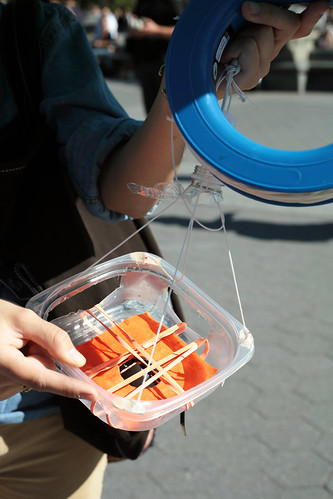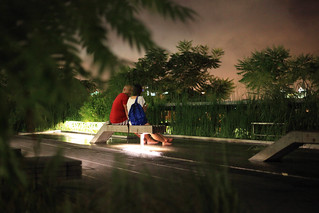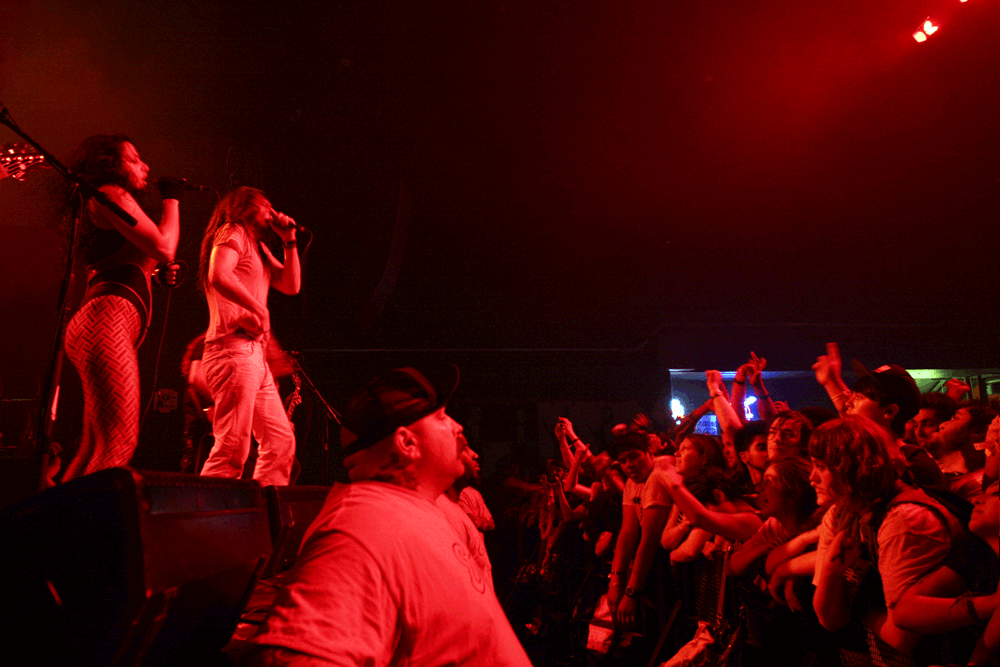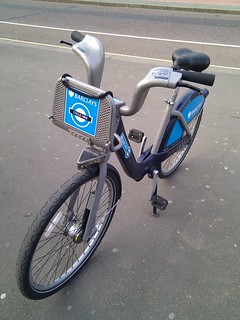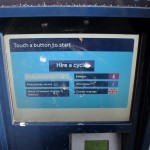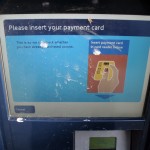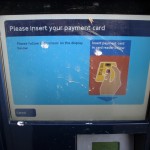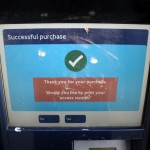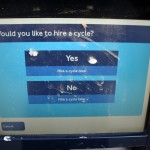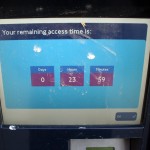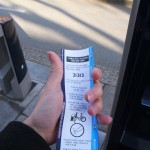The (Un)remarkable Big Green Balloon,
published at 12:09pm on 09/21/12, with 2 Comments
I’ve been spending a lot of time in Washington Square Park lately.
It’s a really nice park, recently renovated and not ruined the way we had all feared it was going to be. There is a nice fountain in the middle, there are benches around the fountain, and there are a good number of people always sitting, eating, reading, singing and dancing in that center area around the fountain. And yesterday, there was a balloon. Sitting on the edge of the fountain, I watched as the giant green balloon dipped up and down, brushing past trees and the arch leading to Fifth Avenue, grazing past the flagpole and just gently slipping past the lamp posts. The balloon was attached to a string, and the string was attached to a young man who was deftly maneuvering the balloon around the park. Suspended under the balloon was a cradle, and in the cradle, what looked like a digital camera.
A mapping project.
Speaking to the two students who were responsible for the balloon, I learned that it was a project for a class at Parsons, in conjunction with Intel and IBM. I’m curious to see the footage that they gathered, and to see the results of the project and how it relates to Grassroots Mapping (which I know about through my involvement with the Awesome Foundation, which recently funded a related project).
But the most remarkable thing about the balloon, was just how unremarkable the rest of the visitors to the park found it. Though they did gather a small crowd who took an active interest in the path of the balloon, gasping as it dove down toward the fountain and cheering as it cleared the trees, the rest of the New York paid it no mind at all, stepping over or under the string as it blocked their paths, and simply ignoring the two kids running around the park chasing the big, green balloon.
Nothing is remarkable in New York City, which is, in itself, remarkable.
Filed under: Observations, with 2 Comments
A High Line For Me, Not You,
published at 12:08pm on 08/31/12, with No Comments
“If you’re tired of a High Line that is full of tourists then stop acting like a fucking tourist.”
This is what I thought the other night as I was strolling down the High Line at 10pm on a Monday night after taking a walk through Chelsea because I realized that I hadn’t left the house all day1.
It was my father who had originally sent me the op-ed about the High Line with the comment “what did this guy expect-that the high line was built just for his personal enjoyment. probably, which is why he’s so bitter now.2” I wasn’t really on board with that assessment. While I am a beneficiary of much of the gentrification in this city (I moved here in the late 90s, post-graffiti, post-crime), I certainly appreciate that many of the reasons that people move here in the first place (the art, the culture, and that fact that all of these things are integrated into the fabric of the city instead of tucked away in some little art ghetto) are quickly moving away.
This stems from two sources: first, the city government is promoting development at any cost to anyone with a backhoe and blueprints, and second, because these things just happen in cycles. Things are pretty great in New York City right now, and in Manhattan in particular. This means that people, and more importantly businesses, are going to want to move here. And those businesses are not going to be manufacturing businesses, and those people are mostly going to have money. You’re just not going to see a lot of small belt makers and auto body shops because that’s not really how people live any more, in this city or in this country. The way to really stem the tide of big box stores is to encourage people to go shopping at their local mom-and-pop, and to pay more and to support the fabric of their community. But, you know, good luck with that.
But that’s not even the thing that bugged me so much about the op-ed. The thing that really annoyed me was this notion that the High Line is now merely a tourist trap, “another stop on the must-see list for out-of-towners.”
As the High Line’s hype grew, the tourists came clamoring. Originally meant for running freight trains, the High Line now runs people, except where those people jam together like spawning salmon crammed in a bottleneck. The park is narrow, and there are few escape routes. I’ve gotten close to a panic attack, stuck in a pool of stagnant tourists at the park’s most congested points.
Of course, this is accurate. If you go to the High Line on a beautiful weekend afternoon, you will fear for your life. But honestly, what kind of New Yorker are you that you’re just going somewhere whenever everyone else is going there? No, a real New Yorker will seek out those moments when this city peels back its exterior (gritty, shiny, whatever phase it happens to be going through at the time) and reveals just a little bit of itself just to you. As I walked along the High Line from 18th Street down to its start at Gansevoort, I stopped at one of the wide wooden recliners that line the middle of that path. And as I sat there, looking at the stars through the clouds, I watched a couple take off their shoes and shuffle their feet through the water feature that was built into the pathway. She stamped her feet and splashed water onto both of their legs and they both laughed. I watched the family, most likely tourists from another part of the city, walking along quietly. And I sat, watching absolutely nothing. Minutes, five, ten at a time would pass and nobody would walk past. Two friends were about to walk by when one stopped and suggested that they stop and sit on the recliner next to mine. Separated by trees and tall grass, they completed disappeared from view when they sat.
To live in New York is to be constantly bombarded by every possible kind of stimulation at every possible moment of the day. Or rather, it can be. To truly live in New York is to find your own pace, to understand that you can not possibly experience every facet of the city, ever, and to pick and choose those things that make you happy. I too fear a city that is built only for tourists, but at the end of the day, only those of us who can learn to navigate the insanity of daily life here are going to stay and call it home.
1. So actually, it was my Fuel Band that reminded me that I was only a quarter of the way to my already woefully low daily goal, and that if I didn’t leave the house a) I would feel really, really bad about myself and b) I would be losing the nearly two-month streak that I was on. Say what you will about the Quantified Self movement, but anything that is going to remind me to get up and move my butt is probably a good thing. The numbers, at least the way I’m using it, don’t really mean too much to me. A friend of mine recently told me that I needed to set a much higher goal, but I realized that I wasn’t wearing the band for him, I was wearing it for me, and if having this little band of rubber and circuits on my wrist was going to get me up and walking around more, then that was plenty. I didn’t have anything to prove to him (or the rest of my social graph, for that matter, so forget you, Facebook connect).
2. My father often writes emails like this, often sans punctuation or capitalization. It’s quite nice, actually. It’s like I have a constant portal open to his consciousness all day through my inbox.
Filed under: Personal, with No Comments
The Sneakiest Ryanair Fee,
published at 9:07am on 07/17/12, with 15 Comments
I recently had the misfortune of booking a Ryanair flight and discovered a secret little $20 fee hidden behind a checkbox.
First of all, if you’ve never had the pleasure of purchasing a ticket from Ryanair, especially out of London, I would highly recommend avoiding it at all costs. The problem with flying out of London is that it requires at least three different searches (for the three regional airports) which can not be combined. You then have to do the mental gymnastics involved in figuring out which airport provides the schedule you want, let alone the price that you’re comfortable paying (after all, this is a “budget” airline, so you’re certainly competing on price here). But beyond their abysmally bad web experience, Ryanair are known to charge fees on just about every part of the travel experience, from the £1.50 charge to have an SMS confirmation sent to your phone, to baggage fees for everything besides your one carry-on, to fees for checking in at the airport.
So against all better judgement, I had settled on a flight from Gatwick to Dublin. During the checkout process, however, I noticed that as I entered my credit card information, the ticket price on the web page automatically updated and was listed in both pounds and the converted dollars that I would actually be paying.

It turns out that Ryanair will quote you a ticket price in the currency of the departing country (hence the price quoted in Pounds in this case), but will actually bill you in your home currency (in my case, US Dollars). The interesting bit comes behind the “more information” link, which will show that they have taken the liberty of providing you with their own currency conversion rate which is, as you’ve probably guessed, much worse than the current rate.

At the time, this £235 ticket was quoted by Ryanair as $386, and xe.com as $368. Simply unchecking this box will bill my card in Pounds and will let my credit card company do the actual currency conversion, which should be a lot more fair than the Ryanair rate (not taking into consideration the foreign transaction fees that a lot of cards charge, but that’s another story).
You’re probably going to get screwed by flying Ryanair anyway, but at least make sure that it’s on your own terms.
Filed under: Observations, with 15 Comments
Delight in an Animated GIF,
published at 11:05am on 05/12/12, with No Comments
The animated GIF is a delightful art form that sits solidly in between the still photography and a moving film. As a technology, it’s not much more than a fluke, but as art, it shares a rich history with the zoetrope, the stereograph and even the flip book.
It’s amazing that this one quirk of this one file format can provide such a rich medium for creativity, but it does. As it is such a portable file format, the number of “digital movie to GIF” apps that have cropped up in recent years is quite astounding. The moments captures in the GIFs on If We Don’t, Remember Me are absolutely stunning, and are art unto themselves. They’re a far cry from the “under construction” animations that I first came across in the mid-90s.
But it is the jerky, raw GIFs that really appeal to me. Individually recorded still frames, stitched together in software, endlessly looping back and forth between two, three, or four frames, at most, that I enjoy making the most. While the video GIFs seem like much more of an extension of film, these two-frame animations feel much more like an extension of still photography to me. When I make a still image, I am choosing a particular moment in time to present to my audience. A single moment that has to communicate the entire feeling that I am trying to communicate. When I show that boy smiling, is it a smile that is about to turn into a grimace? A laugh? It’s up to me to tee up the moment, and up to the viewer to follow through.
Animated GIFs let me cheat.
An animated GIF lets me show two or three moments, a before and after, the smile and the grimace. The ice cream cone before and after it topples to the ground. But it also forces me to choose those two moments. It is, in some ways, harder to choose exactly the right frames to convey exactly the right moment, but it is there that lies the challenge and the joy. When a moving image is complete, I often find myself watching the frames flicker back and forth between each other, wondering which moment came first and which came second and wondering when, if ever, time will carry on.
Incidentally, you really should read Anil’s Animated GIFs Triumphant for more thoughts on the humble animated GIF, and check out my gallery of GIFs.
Filed under: Observations, with No Comments
London Bike Share: An American’s Guide,
published at 3:04pm on 04/22/12, with 3 Comments
Enjoy London by bike share, even as an American. Even with one of your silly swipe credit cards.
I love exploring a city by bike. Any city worth its grid will have a public transit system, but in order to really get a sense of the street life, the pace of the city, and the scale, a bike is the only way to get from place to place. The magic of an underground system is great, but you miss out on everything you can see when you go from point A to Z. And walking just takes too damn long.
The last time I was in London, I was pleased to learn that the bike share program had finally implemented a “Casual Use” plan, which allows you to use the bikes on a day-to-day basis without purchasing a membership (which requires UK residency). I was even more excited to see that the machines support American-style swipe credit cards as well as the chip and pin cards that are common in Europe.
Despite the cold January day, I decided to embark on this adventure to see how hard it was going to be for an American to actually use the Boris Bikes in a casual hire capacity. As it turns out, it’s pretty straight forward, with a couple of caveats.
The onscreen instructions walk you through every step of the hire process, but here are the things to note, both about the hiring process and the bikes themselves:
- The machine may not read your card the first time you try. In the cases where it didn’t read the card, I ended up trying again. And again. And again until it finally worked. The first machine I tried didn’t read the card at all, so I walked to the next bike share station, but I’m not sure whether persistence would have paid off.
- The first time you use the system, you have to swipe your card twice: once to register your card with the system, and once to actual hire the bicycle. On subsequent hires in the rental period (I always did it for £1 for one day, but you can register for longer) you will only need to swipe the card once to check the bike out again.
- You will receive two pieces of paper: the receipt for your rental, and the unlock code, a 5 digit number that you punch into the lock next to the bike you wish to borrow. You need that number to unlock your bike, so remember it before you cram the paper into your pocket.
- The first 30 minutes of the bicycle hire is free. As long as you check your bike back into a station before that 30 minutes is up, you won’t have to pay more than the initial fee for the day. You can’t however, just check out another bike when you park your first one – you will have to wait 15 minutes or so.
- Carry a handkerchief with you – someone had squeezed toothpaste on the seats of all of the bikes at the station I went to one morning. Because people are assholes.
- Watch out for bum bicycles. Before unlocking, I always make sure that the seat adjusts properly and that the tires aren’t flat. The Boris Bikes are incredibly heavy as it is, and a flat tire will make the ride even more painful.
- On a related note, allow at least 50% more time than you’d expect for a bike ride of any given distance – the bikes are heavy and are not geared for going fast.
- After you unlock your bike, getting it out of the stand is actually kind of tricky. You end up having to kind of lift up the seat and lift/pull it out of the stand. If you can’t get the bike out immediately, the lock will reengage itself. Don’t worry – you can just punch in the same code and it will unlock again.
- There are a number of mobile apps that will tell you where the nearest station is. These were indispensable. If you need a mobile data plan, read my tips on getting a mobile data plan while abroad.
- RIDE ON THE LEFT SIDE OF THE ROAD.
That’s it. Especially as the weather starts warming up, I highly recommend that anyone visiting London take full advantage of the bike share system. It really is a wonderful way to get around town.
Filed under: Observations, with 3 Comments


